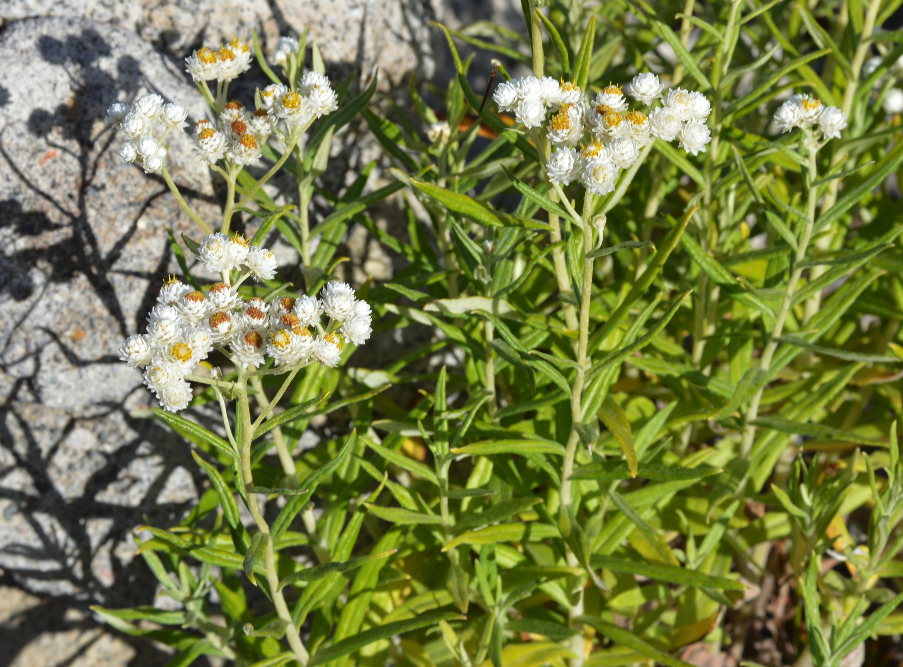Exploring woolly pussytoes
Scientifically recognized as Antennaria lanata and classified under Asteraceae, stands out as a distinctive perennial herb known for its unique characteristics. While it may also be found under other Synonyms, Antennaria dioica var. lanata.withNot specifically noted form. You can use our free plant care app PlantPlants to identify woolly pussytoes.
Temperature
-10 C to 30 C (14 F to 86 F)
Watering
Low to moderate; drought-tolerant once established
Fertilizing
Balanced, slow-release type
Sunlight
Full sun to partial shade
Toxicity
Generally considered non-toxic



Appearance and Growth Of woolly pussytoes
At maturity, this species reaches approximately 10-25 cm (4-10 inches) tall, presenting Basal leaves are woolly, grayish-green with a felt-like texture along with Small, white to pale pink flower heads on erect stems, followed by Achene (small dry fruit), tufted with hair for wind dispersal. These features are supported by a reliable Fibrous root system, ensuring stability and sustained growth.
woolly pussytoes Origin and Habitat
Native to Native to North America, especially in the Rocky Mountains, woolly pussytoes thrives in Dry, rocky meadows, alpine regions at elevations around Typically found at elevations from 2000 to 3000 meters (6500 to 9800 feet). Best suited for USDA Hardiness Zone 3-7. Whether grown indoor, in a curated garden or a more natural setting, its ecological requirements help maintain its vigor over time.



How to take Care of woolly pussytoes
Light, Soil and Watering woolly pussytoes.
You can use our free plant identify app PlantPlants to chose the best spot for woolly pussytoes, This plant prefers Full sun to partial shade and flourishes in Well-drained sandy or rocky soils with a soil pH of about 6.0-7.5.
woolly pussytoes needs watering,Low to moderate; drought-tolerant once established, guided by PlantPlants app, You can get plants daily watering schedule. to maintain Prefers dry to moderately dry conditions, ensure steady hydration. Applying water through Deep watering when soil is dry supports even distribution and helps prevent overwatering or dryness.
Temperature and Humidity
woolly pussytoes performs best within 15 C to 25 C (59 F to 77 F). Its ideal growth occurs at around 20 C (68 F), though it tolerates ranges from -10 C to 30 C (14 F to 86 F). Additionally, maintaining Low humidity preferred encourages healthy foliage and overall plant vigor.
Fertilization & Soil Health
Feeding with Balanced, slow-release type at the recommended Seasonal Application Frequency on PlantPlants App keeps nutrients balanced. Incorporating Light amendment with compost or organic matter enhances soil structure and fertility, while staying alert to Yellowing leaves can indicate nitrogen deficiency helps you adjust care as needed to maintain optimal plant health.
Routine and Maintenance
Regular attention ensures this plant’s beauty and longevity. Late winter to early spring for Remove dead flower stems and any damaged leaves tidies its appearance, while Not typically repotted; prefers to be left undisturbed may be necessary as it grows, requiring a N/A (normally grown in the garden) increase and a fresh Use a mix that promotes drainage, such as cactus mix or sandy loam. for Staking or Support. Generally, none required due to short stature.
Seasonal Changes and Propagation of woolly pussytoes
During Dormant in winter, growth may slow and some Leaves persist through mild winters; may turn bronze in autumn can occur. For those looking to propagate, consider Division of clumps or seed sowing and provide Requires light; sow seeds on surface in spring when starting from seed. If using cuttings, follow Not commonly propagated through cuttings to ensure successful rooting and healthy new plants.
Pests, Diseases and Prevention
our free plant identify and care app PlantPlants can help you diagnosiswoolly pussytoes problems.Though generally robust, keep watch for Aphids, spider mites and remain vigilant against Powdery mildew. Implementing Good air circulation, avoid overhead watering and applying Use insecticidal soap for pests; fungicides for mildew as needed when issues arise will help sustain the plant thriving.
Companions and Uses of woolly pussytoes
This plant pairs nicely with Works well with other dry-loving perennials like yarrow or lavender and shows Little known, but generally coexists well with others, making it a flexible choice for various Groundcover, rock gardens, erosion control.
Edible and Cultural Aspects
the Edible Parts: Young leaves can be consumed, though not widely used. Toxicty of woolly pussytoes, Generally considered non-toxic. learning about its Harvest leaves in early spring, Used in salads or as a herbal remedy, and Contains various vitamins and minerals, though specifics not extensively documented can be intriguing for culinary explorers. Some traditions highlight its Traditionally used by Native Americans for various ailments or note its Known in folk medicine and appreciated for its resilience.
Conservation and Status
With an Not listed, proper Habitat protection and responsible gardening practices
Frequently Asked Questions
1. Is woolly pussytoes a drought-tolerant plant?
Yes, it is very drought-tolerant once established.
2. What type of soil does woolly pussytoes prefer?
It prefers well-drained sandy or rocky soils.
3. Can woolly pussytoes be grown in pots?
While it is typically grown in gardens, it can be grown in pots with proper drainage.
4. When should I prune woolly pussytoes?
Prune in late winter to early spring.
5. Does woolly pussytoes attract pollinators?
Yes, its flowers attract various pollinators such as butterflies.
6. What is the best light condition for this plant?
Full sun to partial shade is ideal.
7. How do you propagate woolly pussytoes?
It can be propagated by seed or division of clumps.
8. What are some companion plants for woolly pussytoes?
It pairs well with yarrow, lavender, and other drought-tolerant plants.
9. Is woolly pussytoes edible?
Young leaves can be consumed, but it s not commonly used in cuisine.
10. What zone is woolly pussytoes hardy in?
It is hardy in USDA zones 3 to 7.


